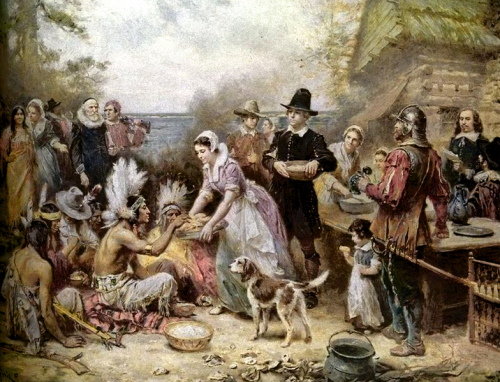The First Thanksgiving", le premier thanksgiving
In this painting by Jean Louis Gerome Ferris (1863-1930), entitled "The First Thanksgiving" Indians are the guests of honor at the party.
The artist describes his way, in fact, the first Thanksgiving celebration. The story goes that it took place a year after the arrival in Massachusetts, the Mayflower, the ship loaded with pilgrims Puritans fleeing England in 1620.
The winter was cold and the new settlers were no farmers. Of the one hundred and two that landed on the floor of the New World, half of them perished. However, this is a Wampanoag Indian tribe that saved the rest of the community. They say he offered them food and taught them to grow corn, to hunt and fish. Later in the fall, when the first harvest was organized three days of prayer and celebration where settlers shared their meals with the chief Massasoit and 90 other Indians. It was to thank them and to establish a lasting friendship .....
It is also said that wild turkeys and pigeons were served on this occasion.
Two years later, the end of harvest was celebrated again. But the reference to Indians vanished thanks not to make in respect of God. After the death of the Indian chief who guaranteed peace, the Wampanoag were finally exterminated in 1676!
Nowadays, it is the turkey has become the symbol of this celebration. We milions fifty shades for the occasion and the president of the New World magnanimously pardons officially in two. Recognition for this beautiful bird!
Dans ce tableau de Jean-Louis Gérôme Ferris (1863-1930), intitulé “Le premier thanksgiving“, les Indiens sont les invités d’honneur de la fête.
Le peintre décrit à sa manière, en effet, la première célébration de Thanksgiving. L’histoire raconte qu’elle eut lieu un an après l’ arrivée dans le Massachussets, du Mayflower, ce bateau chargé de pélerins puritains fuyant l’Angleterre en 1620.
L’hiver était froid et les nouveaux colons n’étaient nullement agriculteurs. Sur les cent deux ayant débarqué sur le sol du Nouveau Monde, la moitié d’entre eux périrent. Or, c’est un Indien de la tribu Wampanoag qui sauva le reste de la communauté. On dit qu’il leur offrit de la nourriture et leur apprit à cultiver du maïs, à chasser et à pêcher. Plus tard, à l’automne, lors de la première récolte, on organisa trois jours de prière et de fête où les colons partagèrent leur repas avec le chef Massasoit et 90 autres Indiens. Il s’agissait de les remercier et d’établir une amitié durable…..
On dit encore que des dindes sauvages et des pigeons furent servis à cette occasion .
Deux ans plus tard, la fin des récoltes fut à nouveau fêtée. Mais la référence aux Amérindiens s’évanouit pour ne formuler de remerciements qu’à l’égard de dieu. Après la mort du chef indien qui garantissait la paix, les Wampanoag furent finalement exterminés en 1676!
De nos jours, c’est la dinde qui est devenue le symbole de cette célébration. On en abat cinquante milions pour la circonstance et le président du Nouveau Monde, magnanime, en grâcie officiellement deux. Belle reconnaissance pour ce volatile!
A découvrir aussi
- NATIVE AMERICAN INDIANS TERRITORIE,territoire indien
- Native American Culture Culture amérindienne
- GÉNOCIDE AMÉRINDIEN
Inscrivez-vous au site
Soyez prévenu par email des prochaines mises à jour
Rejoignez les 76 autres membres

